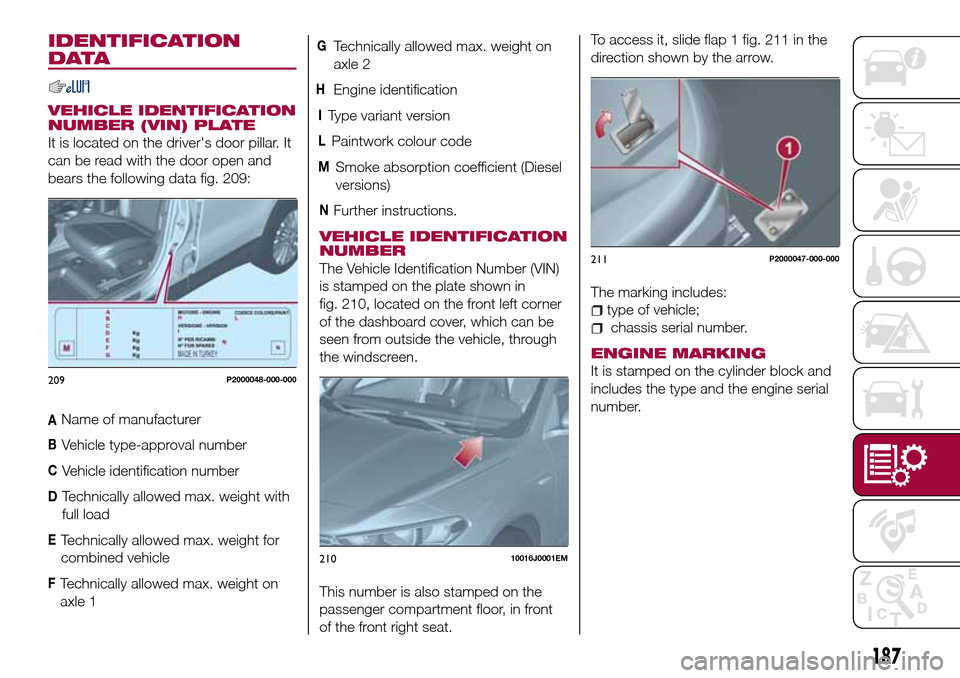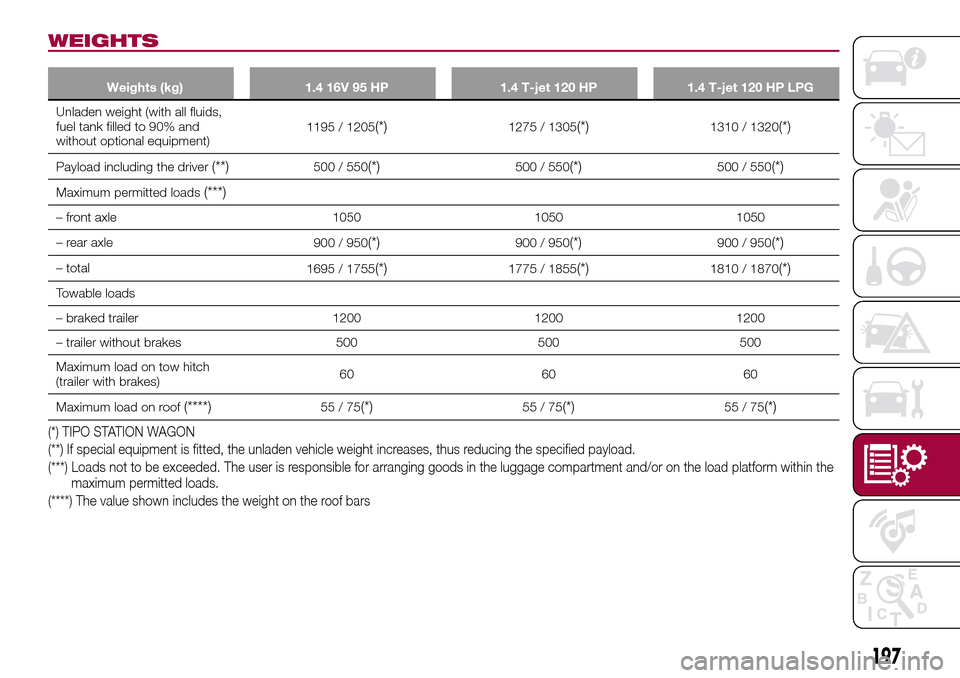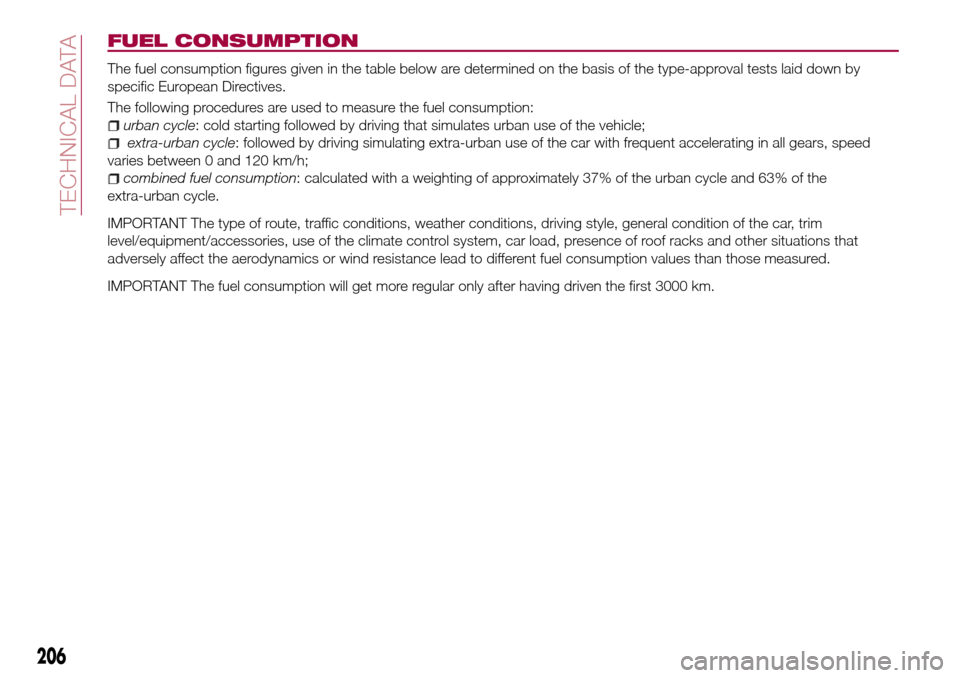Page 189 of 264

IDENTIFICATION
DATA
VEHICLE IDENTIFICATION
NUMBER (VIN) PLATE
It is located on the driver's door pillar. It
can be read with the door open and
bears the following data fig. 209:
AName of manufacturer
BVehicle type-approval number
CVehicle identification number
DTechnically allowed max. weight with
full load
ETechnically allowed max. weight for
combined vehicle
FTechnically allowed max. weight on
axle 1
GTechnically allowed max. weight on
axle 2
HEngine identification
IType variant version
LPaintwork colour code
MSmoke absorption coefficient (Diesel
versions)
NFurther instructions.
VEHICLE IDENTIFICATION
NUMBER
The Vehicle Identification Number (VIN)
is stamped on the plate shown in
fig. 210, located on the front left corner
of the dashboard cover, which can be
seen from outside the vehicle, through
the windscreen.
This number is also stamped on the
passenger compartment floor, in front
of the front right seat.To access it, slide flap 1 fig. 211 in the
direction shown by the arrow.
The marking includes:
type of vehicle;
chassis serial number.
ENGINE MARKING
It is stamped on the cylinder block and
includes the type and the engine serial
number.209P2000048-000-000
21010016J0001EM
211P2000047-000-000
187
Page 199 of 264

WEIGHTS
Weights (kg) 1.4 16V 95 HP 1.4 T-jet 120 HP 1.4 T-jet 120 HP LPG
Unladen weight (with all fluids,
fuel tank filled to 90% and
without optional equipment)1195 / 1205(*)1275 / 1305(*)1310 / 1320(*)
Payload including the driver(**)500 / 550(*)500 / 550(*)500 / 550(*)
Maximum permitted loads(***)
– front axle 1050 1050 1050
– rear axle
900 / 950
(*)900 / 950(*)900 / 950(*)
– total
1695 / 1755(*)1775 / 1855(*)1810 / 1870(*)
Towable loads
– braked trailer 1200 1200 1200
– trailer without brakes 500 500 500
Maximum load on tow hitch
(trailer with brakes)60 60 60
Maximum load on roof
(****)55/75(*)55/75(*)55/75(*)
(*) TIPO STATION WAGON
(**) If special equipment is fitted, the unladen vehicle weight increases, thus reducing the specified payload.
(***) Loads not to be exceeded. The user is responsible for arranging goods in the luggage compartment and/or on the load platform within the
maximum permitted loads.
(****) The value shown includes the weight on the roof bars
197
Page 200 of 264
Weights (kg) 1.3 MultiJet 95 HP 1.6 Multijet 120 HP
Unladen weight (with all fluids, fuel tank filled
to 90% and without optional equipment)1290 / 1300(*)1295 / 1320(*)
Payload including the driver(**)500 / 550(*)500 / 550(*)
Maximum permitted loads(***)
– front axle 1050 1050
– rear axle
900 / 950
(*)900 / 950(*)
– total
1790 / 1850(*)1795 / 1870(*)
Towable loads
– braked trailer 1200 1200
– trailer without brakes 500 500
Maximum load on tow hitch (trailer with
brakes)60 60
Maximum load on roof
(****)55/75(*)55/75(*)
(*) TIPO STATION WAGON
(**) If special equipment is fitted, the unladen vehicle weight increases, thus reducing the specified payload.
(***) Loads not to be exceeded. The user is responsible for arranging goods in the luggage compartment and/or on the load platform within the
maximum permitted loads.
(****) The value shown includes the weight on the roof bars
198
TECHNICAL DATA
Page 208 of 264

FUEL CONSUMPTION
The fuel consumption figures given in the table below are determined on the basis of the type-approval tests laid down by
specific European Directives.
The following procedures are used to measure the fuel consumption:
urban cycle: cold starting followed by driving that simulates urban use of the vehicle;
extra-urban cycle: followed by driving simulating extra-urban use of the car with frequent accelerating in all gears, speed
varies between 0 and 120 km/h;
combined fuel consumption: calculated with a weighting of approximately 37% of the urban cycle and 63% of the
extra-urban cycle.
IMPORTANT The type of route, traffic conditions, weather conditions, driving style, general condition of the car, trim
level/equipment/accessories, use of the climate control system, car load, presence of roof racks and other situations that
adversely affect the aerodynamics or wind resistance lead to different fuel consumption values than those measured.
IMPORTANT The fuel consumption will get more regular only after having driven the first 3000 km.
206
TECHNICAL DATA
Page 261 of 264
Steering wheel...............21
Steering wheel controls.........237
Stop/Start system............111
TC (system)................74
Technical data..............187
Third brake light (bulb
replacement)..............140
Toolbox...................36
Towing the vehicle............159
Towing trailers..............127
Trip Computer...............58TSC (system)................75
Tyres (inflation pressure)........192
Uconnect 3” Radio...........213
Uconnect 5” LIVE — Uconnect 5”
Nav LIVE................222
Uconnect 7" HD LIVE - Uconnect
7" HD Nav LIVE............234
Use of the Owner Handbook.......3
Using the transmission.........111
Vehicle changes/alterations.......4
Version with LPG system........41
Warning lights and messages.....59
Weights..................197
Wheels...................190
Wheels and tyres.............182
Window bag...............105
Windows (cleaning)...........184
Windscreen wiper
replacing wiper blades.......180
Windscreen/rear window wiper....26
Page:
< prev 1-8 9-16 17-24